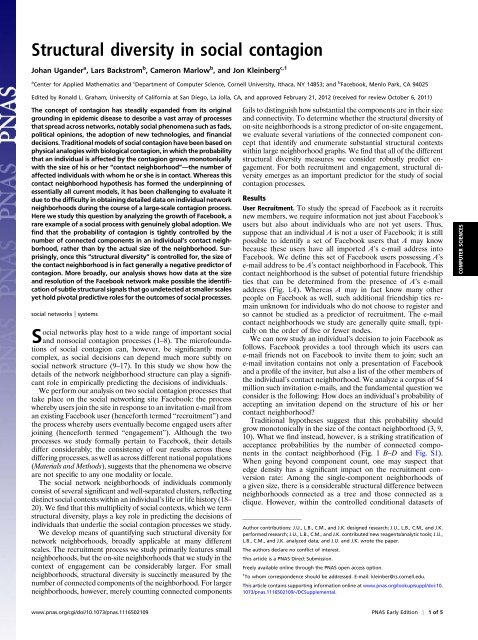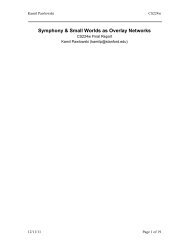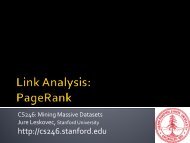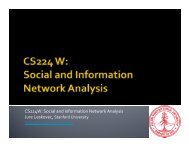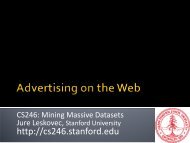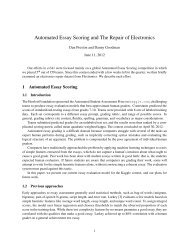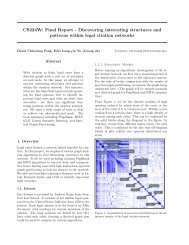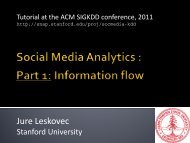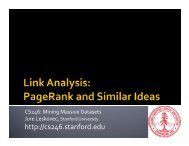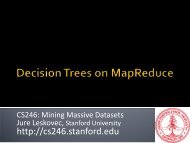Structural diversity in social contagion - Proceedings of the National ...
Structural diversity in social contagion - Proceedings of the National ...
Structural diversity in social contagion - Proceedings of the National ...
You also want an ePaper? Increase the reach of your titles
YUMPU automatically turns print PDFs into web optimized ePapers that Google loves.
<strong>Structural</strong> <strong>diversity</strong> <strong>in</strong> <strong>social</strong> <strong>contagion</strong><br />
Johan Ugander a , Lars Backstrom b , Cameron Marlow b , and Jon Kle<strong>in</strong>berg c,1<br />
a Center for Applied Ma<strong>the</strong>matics and c Department <strong>of</strong> Computer Science, Cornell University, Ithaca, NY 14853; and b Facebook, Menlo Park, CA 94025<br />
Edited by Ronald L. Graham, University <strong>of</strong> California at San Diego, La Jolla, CA, and approved February 21, 2012 (received for review October 6, 2011)<br />
The concept <strong>of</strong> <strong>contagion</strong> has steadily expanded from its orig<strong>in</strong>al<br />
ground<strong>in</strong>g <strong>in</strong> epidemic disease to describe a vast array <strong>of</strong> processes<br />
that spread across networks, notably <strong>social</strong> phenomena such as fads,<br />
political op<strong>in</strong>ions, <strong>the</strong> adoption <strong>of</strong> new technologies, and f<strong>in</strong>ancial<br />
decisions. Traditional models <strong>of</strong> <strong>social</strong> <strong>contagion</strong> have been based on<br />
physical analogies with biological <strong>contagion</strong>, <strong>in</strong> which <strong>the</strong> probability<br />
that an <strong>in</strong>dividual is affected by <strong>the</strong> <strong>contagion</strong> grows monotonically<br />
with <strong>the</strong> size <strong>of</strong> his or her “contact neighborhood”—<strong>the</strong> number <strong>of</strong><br />
affected <strong>in</strong>dividuals with whom he or she is <strong>in</strong> contact. Whereas this<br />
contact neighborhood hypo<strong>the</strong>sis has formed <strong>the</strong> underp<strong>in</strong>n<strong>in</strong>g <strong>of</strong><br />
essentially all current models, it has been challeng<strong>in</strong>g to evaluate it<br />
due to <strong>the</strong> difficulty <strong>in</strong> obta<strong>in</strong><strong>in</strong>g detailed data on <strong>in</strong>dividual network<br />
neighborhoods dur<strong>in</strong>g <strong>the</strong> course <strong>of</strong> a large-scale <strong>contagion</strong> process.<br />
Here we study this question by analyz<strong>in</strong>g <strong>the</strong> growth <strong>of</strong> Facebook, a<br />
rare example <strong>of</strong> a <strong>social</strong> process with genu<strong>in</strong>ely global adoption. We<br />
f<strong>in</strong>d that <strong>the</strong> probability <strong>of</strong> <strong>contagion</strong> is tightly controlled by <strong>the</strong><br />
number <strong>of</strong> connected components <strong>in</strong> an <strong>in</strong>dividual’s contact neighborhood,<br />
ra<strong>the</strong>r than by <strong>the</strong> actual size <strong>of</strong> <strong>the</strong> neighborhood. Surpris<strong>in</strong>gly,<br />
once this “structural <strong>diversity</strong>” is controlled for, <strong>the</strong> size <strong>of</strong><br />
<strong>the</strong> contact neighborhood is <strong>in</strong> fact generally a negative predictor <strong>of</strong><br />
<strong>contagion</strong>. More broadly, our analysis shows how data at <strong>the</strong> size<br />
and resolution <strong>of</strong> <strong>the</strong> Facebook network make possible <strong>the</strong> identification<br />
<strong>of</strong> subtle structural signals that go undetected at smaller scales<br />
yet hold pivotal predictive roles for <strong>the</strong> outcomes <strong>of</strong> <strong>social</strong> processes.<br />
<strong>social</strong> networks | systems<br />
Social networks play host to a wide range <strong>of</strong> important <strong>social</strong><br />
and non<strong>social</strong> <strong>contagion</strong> processes (1–8). The micr<strong>of</strong>oundations<br />
<strong>of</strong> <strong>social</strong> <strong>contagion</strong> can, however, be significantly more<br />
complex, as <strong>social</strong> decisions can depend much more subtly on<br />
<strong>social</strong> network structure (9–17). In this study we show how <strong>the</strong><br />
details <strong>of</strong> <strong>the</strong> network neighborhood structure can play a significant<br />
role <strong>in</strong> empirically predict<strong>in</strong>g <strong>the</strong> decisions <strong>of</strong> <strong>in</strong>dividuals.<br />
We perform our analysis on two <strong>social</strong> <strong>contagion</strong> processes that<br />
take place on <strong>the</strong> <strong>social</strong> network<strong>in</strong>g site Facebook: <strong>the</strong> process<br />
whereby users jo<strong>in</strong> <strong>the</strong> site <strong>in</strong> response to an <strong>in</strong>vitation e-mail from<br />
an exist<strong>in</strong>g Facebook user (henceforth termed “recruitment”) and<br />
<strong>the</strong> process whereby users eventually become engaged users after<br />
jo<strong>in</strong><strong>in</strong>g (henceforth termed “engagement”). Although <strong>the</strong> two<br />
processes we study formally perta<strong>in</strong> to Facebook, <strong>the</strong>ir details<br />
differ considerably; <strong>the</strong> consistency <strong>of</strong> our results across <strong>the</strong>se<br />
differ<strong>in</strong>g processes, as well as across different national populations<br />
(Materials and Methods), suggests that <strong>the</strong> phenomena we observe<br />
are not specific to any one modality or locale.<br />
The <strong>social</strong> network neighborhoods <strong>of</strong> <strong>in</strong>dividuals commonly<br />
consist <strong>of</strong> several significant and well-separated clusters, reflect<strong>in</strong>g<br />
dist<strong>in</strong>ct <strong>social</strong> contexts with<strong>in</strong> an <strong>in</strong>dividual’s life or life history (18–<br />
20). We f<strong>in</strong>d that this multiplicity <strong>of</strong> <strong>social</strong> contexts, which we term<br />
structural <strong>diversity</strong>, plays a key role <strong>in</strong> predict<strong>in</strong>g <strong>the</strong> decisions <strong>of</strong><br />
<strong>in</strong>dividuals that underlie <strong>the</strong> <strong>social</strong> <strong>contagion</strong> processes we study.<br />
We develop means <strong>of</strong> quantify<strong>in</strong>g such structural <strong>diversity</strong> for<br />
network neighborhoods, broadly applicable at many different<br />
scales. The recruitment process we study primarily features small<br />
neighborhoods, but <strong>the</strong> on-site neighborhoods that we study <strong>in</strong> <strong>the</strong><br />
context <strong>of</strong> engagement can be considerably larger. For small<br />
neighborhoods, structural <strong>diversity</strong> is succ<strong>in</strong>ctly measured by <strong>the</strong><br />
number <strong>of</strong> connected components <strong>of</strong> <strong>the</strong> neighborhood. For larger<br />
neighborhoods, however, merely count<strong>in</strong>g connected components<br />
fails to dist<strong>in</strong>guish how substantial <strong>the</strong> components are <strong>in</strong> <strong>the</strong>ir size<br />
and connectivity. To determ<strong>in</strong>e whe<strong>the</strong>r <strong>the</strong> structural <strong>diversity</strong> <strong>of</strong><br />
on-site neighborhoods is a strong predictor <strong>of</strong> on-site engagement,<br />
we evaluate several variations <strong>of</strong> <strong>the</strong> connected component concept<br />
that identify and enumerate substantial structural contexts<br />
with<strong>in</strong> large neighborhood graphs. We f<strong>in</strong>d that all <strong>of</strong> <strong>the</strong> different<br />
structural <strong>diversity</strong> measures we consider robustly predict engagement.<br />
For both recruitment and engagement, structural <strong>diversity</strong><br />
emerges as an important predictor for <strong>the</strong> study <strong>of</strong> <strong>social</strong><br />
<strong>contagion</strong> processes.<br />
Results<br />
User Recruitment. To study <strong>the</strong> spread <strong>of</strong> Facebook as it recruits<br />
new members, we require <strong>in</strong>formation not just about Facebook’s<br />
users but also about <strong>in</strong>dividuals who are not yet users. Thus,<br />
suppose that an <strong>in</strong>dividual A is not a user <strong>of</strong> Facebook; it is still<br />
possible to identify a set <strong>of</strong> Facebook users that A may know<br />
because <strong>the</strong>se users have all imported A’s e-mail address <strong>in</strong>to<br />
Facebook. We def<strong>in</strong>e this set <strong>of</strong> Facebook users possess<strong>in</strong>g A’s<br />
e-mail address to be A’s contact neighborhood <strong>in</strong> Facebook. This<br />
contact neighborhood is <strong>the</strong> subset <strong>of</strong> potential future friendship<br />
ties that can be determ<strong>in</strong>ed from <strong>the</strong> presence <strong>of</strong> A’s e-mail<br />
address (Fig. 1A). Whereas A may <strong>in</strong> fact know many o<strong>the</strong>r<br />
people on Facebook as well, such additional friendship ties rema<strong>in</strong><br />
unknown for <strong>in</strong>dividuals who do not choose to register and<br />
so cannot be studied as a predictor <strong>of</strong> recruitment. The e-mail<br />
contact neighborhoods we study are generally quite small, typically<br />
on <strong>the</strong> order <strong>of</strong> five or fewer nodes.<br />
We can now study an <strong>in</strong>dividual’s decision to jo<strong>in</strong> Facebook as<br />
follows. Facebook provides a tool through which its users can<br />
e-mail friends not on Facebook to <strong>in</strong>vite <strong>the</strong>m to jo<strong>in</strong>; such an<br />
e-mail <strong>in</strong>vitation conta<strong>in</strong>s not only a presentation <strong>of</strong> Facebook<br />
and a pr<strong>of</strong>ile <strong>of</strong> <strong>the</strong> <strong>in</strong>viter, but also a list <strong>of</strong> <strong>the</strong> o<strong>the</strong>r members <strong>of</strong><br />
<strong>the</strong> <strong>in</strong>dividual’s contact neighborhood. We analyze a corpus <strong>of</strong> 54<br />
million such <strong>in</strong>vitation e-mails, and <strong>the</strong> fundamental question we<br />
consider is <strong>the</strong> follow<strong>in</strong>g: How does an <strong>in</strong>dividual’s probability <strong>of</strong><br />
accept<strong>in</strong>g an <strong>in</strong>vitation depend on <strong>the</strong> structure <strong>of</strong> his or her<br />
contact neighborhood?<br />
Traditional hypo<strong>the</strong>ses suggest that this probability should<br />
grow monotonically <strong>in</strong> <strong>the</strong> size <strong>of</strong> <strong>the</strong> contact neighborhood (3, 9,<br />
10). What we f<strong>in</strong>d <strong>in</strong>stead, however, is a strik<strong>in</strong>g stratification <strong>of</strong><br />
acceptance probabilities by <strong>the</strong> number <strong>of</strong> connected components<br />
<strong>in</strong> <strong>the</strong> contact neighborhood (Fig. 1 B–D and Fig. S1).<br />
When go<strong>in</strong>g beyond component count, one may suspect that<br />
edge density has a significant impact on <strong>the</strong> recruitment conversion<br />
rate: Among <strong>the</strong> s<strong>in</strong>gle-component neighborhoods <strong>of</strong><br />
a given size, <strong>the</strong>re is a considerable structural difference between<br />
neighborhoods connected as a tree and those connected as a<br />
clique. However, with<strong>in</strong> <strong>the</strong> controlled conditional datasets <strong>of</strong><br />
Author contributions: J.U., L.B., C.M., and J.K. designed research; J.U., L.B., C.M., and J.K.<br />
performed research; J.U., L.B., C.M., and J.K. contributed new reagents/analytic tools; J.U.,<br />
L.B., C.M., and J.K. analyzed data; and J.U. and J.K. wrote <strong>the</strong> paper.<br />
The authors declare no conflict <strong>of</strong> <strong>in</strong>terest.<br />
This article is a PNAS Direct Submission.<br />
Freely available onl<strong>in</strong>e through <strong>the</strong> PNAS open access option.<br />
1<br />
To whom correspondence should be addressed. E-mail: kle<strong>in</strong>ber@cs.cornell.edu.<br />
This article conta<strong>in</strong>s support<strong>in</strong>g <strong>in</strong>formation onl<strong>in</strong>e at www.pnas.org/lookup/suppl/doi:10.<br />
1073/pnas.1116502109/-/DCSupplemental.<br />
www.pnas.org/cgi/doi/10.1073/pnas.1116502109 PNAS Early Edition | 1<strong>of</strong>5<br />
COMPUTER SCIENCES
A B C D<br />
Fig. 1. Contact neighborhoods dur<strong>in</strong>g recruitment. (A) An illustration <strong>of</strong> a small friendship neighborhood and a highlighted contact neighborhood consist<strong>in</strong>g<br />
<strong>of</strong> four nodes and three components. (B–D) The relative conversion rates for two-node, three-node, and four-node contact neighborhood graphs.<br />
Shad<strong>in</strong>g <strong>in</strong>dicates differences <strong>in</strong> component count. For five-node neighborhoods, see Fig. S1. Invitation conversion rates are reported on a relative scale,<br />
where 1.0 signifies <strong>the</strong> conversion rate <strong>of</strong> one-node neighborhoods. Error bars represent 95% confidence <strong>in</strong>tervals and implicitly reveal <strong>the</strong> relative frequency<br />
<strong>of</strong> <strong>the</strong> different topologies.<br />
one-component neighborhoods <strong>of</strong> sizes 4–6, we see that edge<br />
density has no discernible effect (Fig. 2A).<br />
Moreover, we see that once component count is controlled for<br />
(Fig. 2B), neighborhood size is largely a negative <strong>in</strong>dicator <strong>of</strong> conversion.<br />
In effect, it is not <strong>the</strong> number <strong>of</strong> people who have <strong>in</strong>vited<br />
you, nor <strong>the</strong> number <strong>of</strong> l<strong>in</strong>ks among <strong>the</strong>m, but <strong>in</strong>stead <strong>the</strong> number<br />
<strong>of</strong> connected components <strong>the</strong>y form that captures your probability<br />
<strong>of</strong> accept<strong>in</strong>g <strong>the</strong> <strong>in</strong>vitation. Note that this analysis has been performed<br />
<strong>in</strong> aggregate and thus unavoidably reflects <strong>the</strong> decisions <strong>of</strong><br />
different <strong>in</strong>dividuals. The ability to reliably estimate acceptance<br />
probabilities as a function <strong>of</strong> someth<strong>in</strong>g as specific as <strong>the</strong> precise<br />
topology <strong>of</strong> <strong>the</strong> contact neighborhood is possible only because <strong>the</strong><br />
scale <strong>of</strong> <strong>the</strong> dataset provides us with sufficiently many <strong>in</strong>stances <strong>of</strong><br />
each possible contact neighborhood topology (up through size 5).<br />
We view <strong>the</strong> component count as a measure <strong>of</strong> “structural <strong>diversity</strong>,”<br />
because each connected component <strong>of</strong> an <strong>in</strong>dividual’s<br />
contact neighborhood h<strong>in</strong>ts at a potentially dist<strong>in</strong>ct <strong>social</strong> context<br />
<strong>in</strong> that <strong>in</strong>dividual’s life. Under this view, it is <strong>the</strong> number <strong>of</strong> dist<strong>in</strong>ct<br />
<strong>social</strong> contexts represented on Facebook that predicts <strong>the</strong><br />
probability <strong>of</strong> jo<strong>in</strong><strong>in</strong>g. We show that <strong>the</strong> effect <strong>of</strong> this structural<br />
<strong>diversity</strong> persists even when o<strong>the</strong>r factors are controlled for. In<br />
particular, <strong>the</strong> number <strong>of</strong> connected components <strong>in</strong> <strong>the</strong> contact<br />
neighborhood rema<strong>in</strong>s a predictor <strong>of</strong> <strong>in</strong>vitation acceptance even<br />
when restricted to <strong>in</strong>dividuals whose neighborhoods are demographically<br />
homogeneous (<strong>in</strong> terms <strong>of</strong> sex, age, and nationality;<br />
Fig. S2), thus controll<strong>in</strong>g for a type <strong>of</strong> demographic <strong>diversity</strong><br />
that is potentially dist<strong>in</strong>ct from structural <strong>diversity</strong>. The component<br />
count also rema<strong>in</strong>s a predictor <strong>of</strong> acceptance even when we<br />
compare neighborhoods that exhibit precisely <strong>the</strong> same mixture<br />
<strong>of</strong> “bridg<strong>in</strong>g” and “embedded” l<strong>in</strong>ks (Fig. S3), <strong>the</strong> key dist<strong>in</strong>ction<br />
<strong>in</strong> sociological arguments based on <strong>in</strong>formation novelty (19, 20).<br />
For contact neighborhoods consist<strong>in</strong>g <strong>of</strong> two nodes, we observe<br />
that <strong>the</strong> probability an <strong>in</strong>vitation is accepted is much higher when<br />
<strong>the</strong> two nodes <strong>in</strong> <strong>the</strong> neighborhood are not connected by a l<strong>in</strong>k<br />
(hence form<strong>in</strong>g two connected components, Fig. 1B) compared<br />
with when <strong>the</strong>y are connected (form<strong>in</strong>g one component). Is <strong>the</strong>re<br />
a way to identify cases where people are likely to know each o<strong>the</strong>r,<br />
even if <strong>the</strong>y are not l<strong>in</strong>ked on Facebook? The photo tagg<strong>in</strong>g<br />
feature on Facebook suggests such a mechanism. Photographs<br />
uploaded to Facebook are commonly annotated by users with<br />
“tags” denot<strong>in</strong>g <strong>the</strong> people present <strong>in</strong> <strong>the</strong> photographs. We can<br />
use <strong>the</strong>se tags to deduce whe<strong>the</strong>r two unl<strong>in</strong>ked nodes <strong>in</strong> a contact<br />
neighborhood have been jo<strong>in</strong>tly tagged <strong>in</strong> any photos, a property<br />
we refer to as “co-tagg<strong>in</strong>g,” which serves as an <strong>in</strong>dication <strong>of</strong><br />
a <strong>social</strong> tie through copresence at an event (21).<br />
Us<strong>in</strong>g photo co-tagg<strong>in</strong>g, we f<strong>in</strong>d strong effects even <strong>in</strong> cases<br />
where <strong>the</strong> presence <strong>of</strong> a friendship tie is only implicit. If a contact<br />
neighborhood consists <strong>of</strong> two unl<strong>in</strong>ked nodes that have<br />
never<strong>the</strong>less been co-tagged <strong>in</strong> a photo, <strong>the</strong>n <strong>the</strong> <strong>in</strong>vitation acceptance<br />
probability drops to approximately what it is for a neighborhood<br />
<strong>of</strong> two l<strong>in</strong>ked nodes (Fig. 2C). In o<strong>the</strong>r words, be<strong>in</strong>g cotagged<br />
<strong>in</strong> a photo <strong>in</strong>dicates roughly <strong>the</strong> same lack <strong>of</strong> <strong>diversity</strong> as<br />
be<strong>in</strong>g connected by a friendship l<strong>in</strong>k. We <strong>in</strong>terpret this result as<br />
fur<strong>the</strong>r evidence that diverse endorsement is key to predict<strong>in</strong>g<br />
recruitment. Meanwhile, when <strong>the</strong> two nodes are friends, co-tags<br />
<strong>of</strong>fer a proxy for tie strength, and we see that if <strong>the</strong> two nodes have<br />
also been co-tagged, <strong>the</strong>n <strong>the</strong> probability <strong>of</strong> an accepted <strong>in</strong>vitation<br />
decreases fur<strong>the</strong>r. From this we can <strong>in</strong>terpret tie strength as an<br />
A<br />
B C<br />
Fig. 2. Recruitment contact neighborhoods and component structure. (A)<br />
Conversion as a function <strong>of</strong> edge count neighborhoods with one connected<br />
component (1 CC) with four to six nodes, where variations <strong>in</strong> edge count<br />
predict no mean<strong>in</strong>gful difference <strong>in</strong> conversion. (B) Conversion as a function<br />
<strong>of</strong> neighborhood size, separated by CC count. When component count is<br />
controlled for, size is a negative <strong>in</strong>dicator <strong>of</strong> conversion. (C) Conversion as<br />
a function <strong>of</strong> tie strength <strong>in</strong> two-node neighborhoods, measured by photo<br />
co-tags, a negative <strong>in</strong>dicator <strong>of</strong> predicted conversion. Recruitment conversion<br />
rates are reported on a relative scale, where 1.0 signifies <strong>the</strong> conversion<br />
rate <strong>of</strong> one-node neighborhoods. Error bars represent 95% confidence<br />
<strong>in</strong>tervals.<br />
2<strong>of</strong>5 | www.pnas.org/cgi/doi/10.1073/pnas.1116502109 Ugander et al.
extension <strong>of</strong> context, because two strongly tied nodes plausibly<br />
constitute an even less diverse endorsement neighborhood.<br />
F<strong>in</strong>ally, we study <strong>the</strong> position <strong>of</strong> <strong>the</strong> <strong>in</strong>viter with<strong>in</strong> <strong>the</strong> neighborhood<br />
topologies. When study<strong>in</strong>g recruitment, one might<br />
suspect that <strong>the</strong> structural position <strong>of</strong> <strong>the</strong> <strong>in</strong>viter—<strong>the</strong> person<br />
who extended <strong>the</strong> <strong>in</strong>vitation—might signify differences <strong>in</strong> tie<br />
strength with <strong>the</strong> <strong>in</strong>vitee and <strong>the</strong>refore might significantly affect<br />
<strong>the</strong> predicted conversion rate. We f<strong>in</strong>d that <strong>in</strong>viter position figures<br />
only slightly <strong>in</strong> <strong>the</strong> conversion rate (Fig. 3), with <strong>in</strong>vitations<br />
stemm<strong>in</strong>g from a high-degree position <strong>in</strong> <strong>the</strong> contact neighborhood<br />
predict<strong>in</strong>g only a slightly higher conversion rate than if <strong>the</strong><br />
<strong>in</strong>viter is a peripheral node.<br />
User Engagement. Participation <strong>in</strong> a <strong>social</strong> system such as Facebook<br />
is built upon a spectrum <strong>of</strong> <strong>social</strong> decisions, beg<strong>in</strong>n<strong>in</strong>g with <strong>the</strong><br />
decision to jo<strong>in</strong> (recruitment) and cont<strong>in</strong>u<strong>in</strong>g on to decisions about<br />
how to choose a level <strong>of</strong> engagement. We now show how structural<br />
<strong>diversity</strong> also plays an analogous role <strong>in</strong> this latter type <strong>of</strong> decision<br />
process, study<strong>in</strong>g long-term user engagement <strong>in</strong> <strong>the</strong> Facebook<br />
service. Whereas recruitment is a function <strong>of</strong> <strong>the</strong> complex <strong>in</strong>terplay<br />
between multiple acts <strong>of</strong> endorsement, engagement is a function <strong>of</strong><br />
<strong>the</strong> <strong>social</strong> utility a user derives from <strong>the</strong> service. Our study <strong>of</strong> engagement<br />
focuses on users who registered for Facebook dur<strong>in</strong>g<br />
2010, analyz<strong>in</strong>g <strong>the</strong> <strong>diversity</strong> <strong>of</strong> <strong>the</strong>ir <strong>social</strong> neighborhoods 1 week<br />
after registration as a basis for predict<strong>in</strong>g whe<strong>the</strong>r <strong>the</strong>y will become<br />
highly engaged users 3 months later.<br />
Users are considered engaged at a given time po<strong>in</strong>t if <strong>the</strong>y have<br />
<strong>in</strong>teracted with <strong>the</strong> service dur<strong>in</strong>g at least 6 <strong>of</strong> <strong>the</strong> last 7 days.<br />
Facebook had 845 million monthly active users on December 31,<br />
2011, and dur<strong>in</strong>g <strong>the</strong> month <strong>of</strong> December 2011, an average <strong>of</strong> 360<br />
million users were active on at least 6 out <strong>of</strong> <strong>the</strong> last 7 days. We<br />
def<strong>in</strong>e engagement on a weekly timescale to stabilize <strong>the</strong> considerable<br />
weekly variability <strong>of</strong> user visits. Our goal is <strong>the</strong>refore to<br />
predict whe<strong>the</strong>r a newly registered user will visit Facebook at<br />
least 6 <strong>of</strong> 7 days per week 3 months after registration.<br />
Friendship neighborhoods on Facebook are significantly larger<br />
than <strong>the</strong> e-mail contact neighborhoods from our recruitment<br />
study. We focus our engagement study on a population <strong>of</strong> ∼10<br />
million users who registered dur<strong>in</strong>g 2010 and had assembled<br />
neighborhoods consist<strong>in</strong>g <strong>of</strong> exactly 10, 20, 30, 40, or 50 friends 1<br />
week after registration. For <strong>social</strong> network neighborhoods <strong>of</strong> this<br />
size, we f<strong>in</strong>d that a neighborhood conta<strong>in</strong><strong>in</strong>g a large number <strong>of</strong><br />
connected components primarily <strong>in</strong>dicates a large number <strong>of</strong><br />
one-node components, or “s<strong>in</strong>gletons”, and as such, it is not an<br />
accurate reflection <strong>of</strong> <strong>social</strong> context <strong>diversity</strong>.<br />
Fig. 3. Inviter position dur<strong>in</strong>g recruitment. Shown is recruitment conversion<br />
as a function <strong>of</strong> neighborhood graph topology and <strong>in</strong>viter position <strong>in</strong><br />
neighborhoods <strong>of</strong> size 4. The position <strong>of</strong> <strong>the</strong> <strong>in</strong>viter with<strong>in</strong> <strong>the</strong> neighborhood<br />
graph is described exactly (up to symmetries) by node degree. Shad<strong>in</strong>g<br />
<strong>in</strong>dicates differences <strong>in</strong> component count. Recruitment conversion rates are<br />
reported on a relative scale, where 1.0 signifies <strong>the</strong> conversion rate <strong>of</strong> onenode<br />
neighborhoods. Error bars represent 95% confidence <strong>in</strong>tervals.<br />
To address this, we evaluate three dist<strong>in</strong>ct parametric generalizations<br />
<strong>of</strong> component count. First, we measure <strong>diversity</strong> simply<br />
by consider<strong>in</strong>g only components over a certa<strong>in</strong> size k. Second, we<br />
measure <strong>diversity</strong> by <strong>the</strong> component count <strong>of</strong> <strong>the</strong> k-core <strong>of</strong> <strong>the</strong><br />
neighborhood graph (22), <strong>the</strong> subgraph formed by repeatedly<br />
delet<strong>in</strong>g all vertices <strong>of</strong> degree less than k. Third, we def<strong>in</strong>e a<br />
measure that isolates dense <strong>social</strong> contexts by remov<strong>in</strong>g edges<br />
accord<strong>in</strong>g to <strong>the</strong>ir embeddedness, <strong>the</strong> number <strong>of</strong> common neighbors<br />
shared by <strong>the</strong>ir two endpo<strong>in</strong>ts; <strong>in</strong>tuitively this is an analog, for<br />
edges, <strong>of</strong> <strong>the</strong> type <strong>of</strong> node removal that def<strong>in</strong>es <strong>the</strong> k-core.<br />
Adapt<strong>in</strong>g earlier work on embeddedness by Cohen (23), we def<strong>in</strong>e<br />
<strong>the</strong> k-brace <strong>of</strong> a graph to be <strong>the</strong> subgraph formed by repeatedly<br />
delet<strong>in</strong>g all edges <strong>of</strong> embeddedness less than k and <strong>the</strong>n delet<strong>in</strong>g<br />
all s<strong>in</strong>gle-node connected components. (Cohen’s work was concerned<br />
with a def<strong>in</strong>ition equivalent to <strong>the</strong> largest connected<br />
component <strong>of</strong> <strong>the</strong> k-brace; because we deal with <strong>the</strong> full subgraph<br />
<strong>of</strong> all nontrivial components, it is useful to adapt <strong>the</strong> def<strong>in</strong>itions as<br />
needed.) Examples <strong>of</strong> <strong>the</strong>se three measures applied to a neighborhood<br />
graph are shown <strong>in</strong> Fig. 4 A and B, illustrat<strong>in</strong>g <strong>the</strong><br />
A B<br />
C D<br />
E F<br />
Fig. 4. Engagement and structural <strong>diversity</strong> for 50-node friendship neighborhoods.<br />
(A) Illustration <strong>of</strong> <strong>the</strong> connected components <strong>in</strong> a friendship<br />
neighborhood, del<strong>in</strong>eat<strong>in</strong>g connected components and components <strong>of</strong> size<br />
≥3. (B) Illustration <strong>of</strong> <strong>the</strong> k-core and <strong>the</strong> k-brace, del<strong>in</strong>eat<strong>in</strong>g <strong>the</strong> connected<br />
components <strong>of</strong> <strong>the</strong> 2-core and <strong>the</strong> 1-brace. (C) Engagement as a function <strong>of</strong><br />
connected component count. (D) Engagement as a function <strong>of</strong> <strong>the</strong> number <strong>of</strong><br />
components <strong>of</strong> size ≥ k, fork ¼ 2; 3; 4; 8, with connected component (CC)<br />
count shown for comparison. (E) Engagement as a function <strong>of</strong> k-core component<br />
count for k ¼ 1; 2; 3, with CC count shown for comparison. (F) Engagement<br />
as a function <strong>of</strong> k-brace component count for k ¼ 1; 2, with CC<br />
count shown for comparison. Engagement rates are reported on a relative<br />
scale, where 1.0 signifies <strong>the</strong> average conversion rate <strong>of</strong> all 50-node neighborhoods.<br />
All error bars are 95% confidence <strong>in</strong>tervals. For o<strong>the</strong>r neighborhood<br />
sizes, see Fig. S4.<br />
Ugander et al. PNAS Early Edition | 3<strong>of</strong>5<br />
COMPUTER SCIENCES
connected components <strong>of</strong> size 3 or greater, <strong>the</strong> connected components<br />
<strong>of</strong> <strong>the</strong> 2-core, and <strong>the</strong> connected components <strong>of</strong> <strong>the</strong><br />
1-brace. We see that <strong>the</strong> three parametric measures we evaluate<br />
differ measurably <strong>in</strong> how <strong>the</strong>y isolate “substantial” <strong>social</strong> contexts.<br />
The k-core component count for k ¼ 0 is simply <strong>the</strong> component<br />
count <strong>of</strong> <strong>the</strong> orig<strong>in</strong>al graph, <strong>the</strong> same as we analyzed when<br />
exam<strong>in</strong><strong>in</strong>g recruitment. For k ¼ 1, <strong>the</strong> k-core component count is<br />
<strong>the</strong> count <strong>of</strong> nons<strong>in</strong>gleton components, whereas for k ¼ 2, all<br />
tree-like components are discarded and <strong>the</strong> rema<strong>in</strong><strong>in</strong>g components<br />
are counted. When consider<strong>in</strong>g <strong>the</strong> k-brace, observe that<br />
for all graphs <strong>the</strong> k-brace is a subgraph <strong>of</strong> <strong>the</strong> ðk þ 1Þ-core: <strong>in</strong>deed,<br />
because each node <strong>in</strong> <strong>the</strong> k-brace is <strong>in</strong>cident to at least one<br />
edge, and each edge <strong>in</strong> <strong>the</strong> k-brace has embeddedness at least k,<br />
all nodes <strong>in</strong> <strong>the</strong> k-brace must have degree at least k þ 1. It is<br />
<strong>the</strong>refore reasonable to compare <strong>the</strong> 1-brace to <strong>the</strong> 2-core. Both<br />
<strong>of</strong> <strong>the</strong>se restrictions discard tree-like components, but <strong>the</strong> 1brace<br />
will tend to break up components fur<strong>the</strong>r than <strong>the</strong> 2-core<br />
does—<strong>the</strong> operation def<strong>in</strong><strong>in</strong>g <strong>the</strong> 1-brace cont<strong>in</strong>ues to cleave<br />
components <strong>in</strong> cases where sets <strong>of</strong> nodes form<strong>in</strong>g triangles are<br />
l<strong>in</strong>ked toge<strong>the</strong>r by unembedded edges or where a component<br />
conta<strong>in</strong>s cycles but no triangles. The notion <strong>of</strong> <strong>the</strong> k-core has<br />
been applied both to <strong>the</strong> study <strong>of</strong> critical phenomena <strong>in</strong> random<br />
graphs (24, 25) and to models <strong>of</strong> <strong>the</strong> Internet (26, 27), but to our<br />
knowledge <strong>the</strong> k-brace has not been studied extensively (see SI<br />
Text for some basic results on <strong>the</strong> k-brace and ref. 23 for analysis<br />
<strong>of</strong> a related def<strong>in</strong>ition).<br />
When study<strong>in</strong>g <strong>the</strong> structural <strong>diversity</strong> <strong>of</strong> 1-week Facebook<br />
friendship neighborhoods as a predictor <strong>of</strong> long-term engagement,<br />
simply count<strong>in</strong>g connected components leads to a muddled view <strong>of</strong><br />
predicted engagement (Fig. 4C). However, extend<strong>in</strong>g <strong>the</strong> notion <strong>of</strong><br />
<strong>diversity</strong> accord<strong>in</strong>g to any <strong>of</strong> <strong>the</strong> def<strong>in</strong>itions above suffices to provide<br />
positive predictors <strong>of</strong> future long-term engagement. Specifically,<br />
when consider<strong>in</strong>g <strong>the</strong> components <strong>of</strong> <strong>the</strong> 1-brace, which removes<br />
small components and severs unembedded edges, we see that <strong>diversity</strong><br />
(captured by <strong>the</strong> presence <strong>of</strong> multiple components) emerges<br />
as a significant positive predictor <strong>of</strong> future long-term engagement<br />
(Fig. 4F). We also see that <strong>the</strong> closely related 2-core component<br />
count is a clean predictor (Fig. 4E). F<strong>in</strong>ally, if we consider simply <strong>the</strong><br />
number <strong>of</strong> components <strong>of</strong> size k or larger <strong>in</strong> <strong>the</strong> orig<strong>in</strong>al neighborhood<br />
(without apply<strong>in</strong>g <strong>the</strong> core or brace def<strong>in</strong>itions), we see<br />
that small values <strong>of</strong> k are not enough (Fig. 4D); but even here, when<br />
k is <strong>in</strong>creased to make <strong>the</strong> selection over components sufficiently<br />
astr<strong>in</strong>gent (<strong>in</strong> particular, when we count only components <strong>of</strong> size 8<br />
or larger), a clean <strong>in</strong>dicator <strong>of</strong> engagement aga<strong>in</strong> emerges.<br />
When consider<strong>in</strong>g <strong>the</strong> k-brace, it is sufficient to consider <strong>the</strong><br />
component count <strong>of</strong> <strong>the</strong> 1-brace for our purposes, but larger<br />
values <strong>of</strong> k may be useful for analyz<strong>in</strong>g larger neighborhoods <strong>in</strong><br />
o<strong>the</strong>r doma<strong>in</strong>s. We note that <strong>the</strong> presence <strong>of</strong> several components<br />
<strong>in</strong> <strong>the</strong> k-core and <strong>the</strong> k-brace is fundamentally limited by <strong>the</strong> size<br />
<strong>of</strong> <strong>the</strong> core/brace, and we perform a control <strong>of</strong> this potentially<br />
confound<strong>in</strong>g factor (Fig. S5). The conventional wisdom for <strong>social</strong><br />
systems such as Facebook is that <strong>the</strong>ir utility depends crucially<br />
upon <strong>the</strong> presence <strong>of</strong> a strong <strong>social</strong> context. Our f<strong>in</strong>d<strong>in</strong>gs validate<br />
this view, observ<strong>in</strong>g that <strong>the</strong> predicted engagement for users<br />
who lack any strong context (e.g., those who have zero components<br />
<strong>in</strong> <strong>the</strong>ir neighborhood 1-brace) is much lower than for<br />
those with such a context. Our analysis importantly extends this<br />
view, f<strong>in</strong>d<strong>in</strong>g that <strong>the</strong> presence <strong>of</strong> multiple contexts <strong>in</strong>troduces<br />
a sizable additional <strong>in</strong>crease <strong>in</strong> predicted engagement.<br />
A cruder approach to <strong>diversity</strong> might consider measur<strong>in</strong>g <strong>diversity</strong><br />
through <strong>the</strong> edge density <strong>of</strong> a neighborhood, figur<strong>in</strong>g that<br />
sparse neighborhoods would be more varied <strong>in</strong> context. In Fig. 5<br />
we see how this approach results <strong>in</strong> a complicated view where <strong>the</strong><br />
optimal edge density for predict<strong>in</strong>g engagement lies at an <strong>in</strong>ternal<br />
and size-dependent optimum. Given what our component analysis<br />
reveals, we <strong>in</strong>terpret this observation as a superposition <strong>of</strong> two<br />
effects: Too few edges imply a lack <strong>of</strong> context (4) but too many<br />
edges imply a lack<strong>in</strong>g <strong>diversity</strong> <strong>of</strong> contexts, with a nontrivial<br />
Fig. 5. Engagement as a function <strong>of</strong> edge density. For five different<br />
neighborhood sizes, n ¼ 10; 20; 30; 40; 50, we see that when component<br />
count is not accounted for, an <strong>in</strong>ternal engagement optimum is observed,<br />
show<strong>in</strong>g <strong>the</strong> comb<strong>in</strong>ed forces <strong>of</strong> focused context and structural heterogeneity.<br />
Engagement rates are reported on a relative scale, where 1.0 signifies<br />
<strong>the</strong> average conversion rate <strong>of</strong> all 50-node neighborhoods. All error bars are<br />
95% confidence <strong>in</strong>tervals.<br />
<strong>in</strong>terior clearly dom<strong>in</strong>at<strong>in</strong>g <strong>the</strong> boundary conditions. From Fig. 5 it<br />
also becomes clear that <strong>in</strong>ternal neighborhood structure is at least<br />
as important as size, with a 20-node neighborhood featur<strong>in</strong>g a<br />
well-balanced density predict<strong>in</strong>g higher conversion than a sparse<br />
or dense 50-node neighborhood.<br />
Discussion<br />
Detailed traces <strong>of</strong> Facebook adoption provide natural sources <strong>of</strong><br />
data for study<strong>in</strong>g <strong>social</strong> <strong>contagion</strong> processes. Our analysis provides<br />
a high-resolution view <strong>of</strong> a massive <strong>social</strong> <strong>contagion</strong> process<br />
as it unfolded over time and suggests a reth<strong>in</strong>k<strong>in</strong>g <strong>of</strong> <strong>the</strong> underly<strong>in</strong>g<br />
mechanics by which such processes operate. Ra<strong>the</strong>r than<br />
treat<strong>in</strong>g a person’s number <strong>of</strong> neighbors as <strong>the</strong> crucial parameter,<br />
consider <strong>in</strong>stead <strong>the</strong> number <strong>of</strong> dist<strong>in</strong>ct <strong>social</strong> contexts that <strong>the</strong>se<br />
neighbors represent as <strong>the</strong> driv<strong>in</strong>g mechanism <strong>of</strong> <strong>social</strong> <strong>contagion</strong>.<br />
The role <strong>of</strong> neighborhood <strong>diversity</strong> <strong>in</strong> <strong>contagion</strong> processes suggests<br />
<strong>in</strong>terest<strong>in</strong>g fur<strong>the</strong>r directions to pursue, both for ma<strong>the</strong>matical<br />
model<strong>in</strong>g and for potential broader applications. Ma<strong>the</strong>matical<br />
models <strong>in</strong> areas <strong>in</strong>clud<strong>in</strong>g <strong>in</strong>teract<strong>in</strong>g particle systems (28, 29) and<br />
threshold <strong>contagion</strong> (3, 30) have explored some <strong>of</strong> <strong>the</strong> global phenomena<br />
that arise from <strong>contagion</strong> processes <strong>in</strong> networks for<br />
which <strong>the</strong> behavior at a given node has a nontrivial dependence<br />
on <strong>the</strong> full set <strong>of</strong> behaviors at neighbor<strong>in</strong>g nodes. Neighborhood<br />
<strong>diversity</strong> could be naturally <strong>in</strong>corporated <strong>in</strong>to such models by<br />
bas<strong>in</strong>g <strong>the</strong> underly<strong>in</strong>g <strong>contagion</strong> probability, for example, on <strong>the</strong><br />
number <strong>of</strong> connected components formed by a node’s affected<br />
neighbors. It <strong>the</strong>n becomes a basic question to understand how<br />
<strong>the</strong> global properties <strong>of</strong> <strong>the</strong>se processes change when such factors<br />
are <strong>in</strong>corporated.<br />
More broadly, across a range <strong>of</strong> fur<strong>the</strong>r doma<strong>in</strong>s, <strong>the</strong>se f<strong>in</strong>d<strong>in</strong>gs<br />
suggest an alternate perspective for recruitment to political<br />
causes, <strong>the</strong> promotion <strong>of</strong> health practices, and market<strong>in</strong>g; to<br />
conv<strong>in</strong>ce <strong>in</strong>dividuals to change <strong>the</strong>ir behavior, it may be less<br />
important that <strong>the</strong>y receive many endorsements than that <strong>the</strong>y<br />
receive <strong>the</strong> message from multiple directions. In this way, our<br />
f<strong>in</strong>d<strong>in</strong>gs propose a potential revision <strong>of</strong> core <strong>the</strong>ories for <strong>the</strong><br />
roles that networks play across <strong>social</strong> and economic doma<strong>in</strong>s.<br />
Materials and Methods<br />
Recruitment Data Collection. Here we discuss details <strong>of</strong> <strong>the</strong> e-mail recruitment<br />
data. All user data were analyzed <strong>in</strong> an anonymous, aggregated form. The<br />
contact neighborhood <strong>in</strong>dividuals <strong>in</strong>cluded <strong>in</strong> <strong>in</strong>vitation e-mails are limited to<br />
n<strong>in</strong>e <strong>in</strong> number, and so we have restricted our analysis to neighborhoods<br />
(<strong>in</strong>viter plus contact importers) <strong>of</strong> 10 nodes or less. In cases with more than<br />
n<strong>in</strong>e candidate “o<strong>the</strong>r people you may know,” <strong>the</strong> <strong>in</strong>vitation tool selects a<br />
randomized subset <strong>of</strong> n<strong>in</strong>e for <strong>in</strong>clusion <strong>in</strong> <strong>the</strong> e-mail.<br />
We conditioned our data collection upon several criteria. First, we considered<br />
only first <strong>in</strong>vitations to jo<strong>in</strong> <strong>the</strong> site. Subsequent <strong>in</strong>vitations to an e-mail address<br />
are handled differently by <strong>the</strong> <strong>in</strong>vitation tool, and so we have not <strong>in</strong>cluded <strong>the</strong>m<br />
<strong>in</strong> our study. Second, we considered only <strong>in</strong>vitations where <strong>the</strong> <strong>in</strong>viter <strong>in</strong>vited at<br />
4<strong>of</strong>5 | www.pnas.org/cgi/doi/10.1073/pnas.1116502109 Ugander et al.
most 20 e-mail addresses on <strong>the</strong> date <strong>of</strong> <strong>the</strong> <strong>in</strong>vitation. This condition<strong>in</strong>g is meant<br />
to omit <strong>in</strong>vitation batches where <strong>the</strong> <strong>in</strong>viter opted to “select all” with<strong>in</strong> <strong>the</strong><br />
contact import tool and focuses our <strong>in</strong>vestigation on <strong>social</strong>ly selective <strong>in</strong>vitations.<br />
Invitations were sent dur<strong>in</strong>g an 11-week period spann<strong>in</strong>g July 12, 2010 to<br />
September 26, 2010. An e-mail address was considered to have converted to<br />
a registered user account if <strong>the</strong> address was registered for an account with<strong>in</strong><br />
14 days <strong>of</strong> <strong>the</strong> <strong>in</strong>vitation, count<strong>in</strong>g both <strong>in</strong>dividuals who signed up via l<strong>in</strong>ks<br />
provided <strong>in</strong> <strong>the</strong> <strong>in</strong>vitation e-mail and users who signed up by visit<strong>in</strong>g <strong>the</strong><br />
Facebook website directly with<strong>in</strong> 14 days. Only contact import events that<br />
occurred before <strong>the</strong> <strong>in</strong>vitation event are considered. Likewise, only friendship<br />
edges that existed before <strong>the</strong> <strong>in</strong>vitation event are considered to be part <strong>of</strong><br />
<strong>the</strong> neighborhood.<br />
Many <strong>of</strong> <strong>the</strong> f<strong>in</strong>d<strong>in</strong>gs we <strong>in</strong>vestigate are governed by complex nonl<strong>in</strong>ear<br />
effects, which make traditional regression controls generally <strong>in</strong>adequate. In<br />
an attempt to control for confound<strong>in</strong>g signals <strong>in</strong> our data, several parallel<br />
observation groups were ma<strong>in</strong>ta<strong>in</strong>ed, aga<strong>in</strong>st which all f<strong>in</strong>d<strong>in</strong>gs were validated.<br />
As a means <strong>of</strong> captur<strong>in</strong>g potential artifacts from duplicitous private/<br />
bus<strong>in</strong>ess e-mail address use, a first such validation group was constructed<br />
by condition<strong>in</strong>g upon e-mail <strong>in</strong>vitations sent to a small set <strong>of</strong> common<br />
and commonly private e-mail providers: Hotmail, Yahoo!, Gmail, AOL, and<br />
Yahoo! France. As a means <strong>of</strong> observ<strong>in</strong>g any differences between already<br />
established and grow<strong>in</strong>g Facebook markets, two parallel validation groups<br />
were constructed to observe established markets (United States) and<br />
emerg<strong>in</strong>g Facebook markets (Brazil, Germany, Japan, and Russia), classified<br />
by <strong>the</strong> most recently resolved country <strong>of</strong> log<strong>in</strong> for <strong>the</strong> <strong>in</strong>vit<strong>in</strong>g Facebook<br />
account. Whereas <strong>in</strong>vitation conversion rates were generally higher <strong>in</strong><br />
emerg<strong>in</strong>g markets, none <strong>of</strong> <strong>the</strong> conditional datasets were observed to deviate<br />
from <strong>the</strong> complete dataset with regard to <strong>in</strong>ternal structural f<strong>in</strong>d<strong>in</strong>gs.<br />
Highly sparse neighborhoods were a very common occurrence <strong>in</strong> <strong>the</strong>se data,<br />
ow<strong>in</strong>g to <strong>the</strong> fact that <strong>the</strong> neighborhoods we study here are only partial<br />
observations <strong>of</strong> an <strong>in</strong>dividual’s actual connection to Facebook. We are able to<br />
<strong>in</strong>fer l<strong>in</strong>ks only to those site users who have used <strong>the</strong> contact importer tool and<br />
ma<strong>in</strong>ta<strong>in</strong> active e-mail communication with <strong>the</strong> e-mail address <strong>in</strong> question,<br />
criteria that <strong>in</strong>duce a sampled subgraph that we <strong>the</strong>n observe. The probability<br />
<strong>of</strong> sampl<strong>in</strong>g an edge uniformly at random <strong>in</strong> any neighborhood with low edge<br />
1. Pastor-Satorras R, Vespignani A (2001) Epidemic spread<strong>in</strong>g <strong>in</strong> scale-free networks.<br />
Phys Rev Lett 86:3200–3203.<br />
2. Newman ME, Watts DJ, Strogatz SH (2002) Random graph models <strong>of</strong> <strong>social</strong> networks.<br />
Proc Natl Acad Sci USA 99(Suppl 1):2566–2572.<br />
3. Dodds PS, Watts DJ (2004) Universal behavior <strong>in</strong> a generalized model <strong>of</strong> <strong>contagion</strong>.<br />
Phys Rev Lett 92:218701.<br />
4. Backstrom L, Huttenlocher D, Kle<strong>in</strong>berg J, Lan X (2006) Group formation <strong>in</strong> large<br />
<strong>social</strong> networks: Membership, growth, and evolution. Proceed<strong>in</strong>gs <strong>of</strong> <strong>the</strong> 12th ACM<br />
SIGKDD International Conference on Knowledge Discovery and Data M<strong>in</strong><strong>in</strong>g, eds<br />
Eliassi-Rad T, Ungar LH, Craven M, Gunopulos D (Association for Comput<strong>in</strong>g Mach<strong>in</strong>ery,<br />
New York), pp 44–54.<br />
5. Kearns M, Suri S, Montfort N (2006) An experimental study <strong>of</strong> <strong>the</strong> color<strong>in</strong>g problem<br />
on human subject networks. Science 313:824–827.<br />
6. Watts DJ, Dodds PS (2007) Influentials, networks, and public op<strong>in</strong>ion formation.<br />
J Consum Res 34:441–458.<br />
7. Christakis NA, Fowler JH (2007) The spread <strong>of</strong> obesity <strong>in</strong> a large <strong>social</strong> network over 32<br />
years. N Engl J Med 357:370–379.<br />
8. Sun E, Rosenn I, Marlow C, Lento T (2009) Gesundheit! Model<strong>in</strong>g <strong>contagion</strong> through<br />
Facebook news feed. Proceed<strong>in</strong>gs <strong>of</strong> <strong>the</strong> AAAI International Conference on Weblogs<br />
and Social Media, eds Adar E, et al. (Association for <strong>the</strong> Advancement <strong>of</strong> Artificial<br />
Intelligence, Menlo Park, CA), pp 146–153.<br />
9. Schell<strong>in</strong>g T (1971) Dynamic models <strong>of</strong> segregation. J Math Sociol 1:143–186.<br />
10. Granovetter M (1978) Threshold models <strong>of</strong> collective action. Am J Sociol 83:<br />
1420–1443.<br />
11. Burt R (1987) Social <strong>contagion</strong> and <strong>in</strong>novation: Cohesion versus structural equivalence.<br />
Am J Sociol 92:1287–1335.<br />
12. Koss<strong>in</strong>ets G, Watts DJ (2006) Empirical analysis <strong>of</strong> an evolv<strong>in</strong>g <strong>social</strong> network. Science<br />
311:88–90.<br />
13. Centola D, Eguíluz V, Macy M (2007) Cascade dynamics <strong>of</strong> complex propagation.<br />
Physica A 374:449–456.<br />
14. Centola D, Macy M (2007) Complex <strong>contagion</strong>s and <strong>the</strong> weakness <strong>of</strong> long ties. Am J<br />
Sociol 113:702–734.<br />
15. Palla G, Barabási AL, Vicsek T (2007) Quantify<strong>in</strong>g <strong>social</strong> group evolution. Nature 446:<br />
664–667.<br />
density is <strong>the</strong>refore quite low, and <strong>the</strong> probability that all sampled nodes come<br />
from <strong>the</strong> same cluster with<strong>in</strong> a clustered neighborhood is lower still. From <strong>the</strong><br />
perspective <strong>of</strong> communication multiplexity (31), we should <strong>in</strong> fact expect that<br />
our randomly <strong>in</strong>duced subgraph sample is biased toward strongly connected<br />
ties that tend to communicate on multiple mediums, but this expectation is not<br />
at issue with our results. The real matter <strong>of</strong> <strong>the</strong> fact is that contact neighborhoods<br />
where <strong>the</strong> <strong>in</strong>duced subgraph consists <strong>of</strong> a s<strong>in</strong>gle connected component<br />
are likely to come from very tightly connected neighborhood graphs.<br />
Although <strong>the</strong> contact importer tool and <strong>in</strong>vitation tool are prom<strong>in</strong>ently<br />
featured as part <strong>of</strong> <strong>the</strong> new user experience on Facebook, <strong>the</strong>y are also<br />
heavily used by experienced users <strong>of</strong> <strong>the</strong> site: The median site age <strong>of</strong> an <strong>in</strong>viter<br />
<strong>in</strong> our dataset was 262 days. Although e-mail <strong>in</strong>vitations constitute only<br />
a small portion <strong>of</strong> Facebook’s growth, <strong>the</strong>y provide a valuable w<strong>in</strong>dow <strong>in</strong>to<br />
<strong>the</strong> o<strong>the</strong>rwise <strong>in</strong>visible growth process <strong>of</strong> <strong>the</strong> Facebook product.<br />
For <strong>the</strong> analysis <strong>of</strong> photo co-tags, only co-tags s<strong>in</strong>ce January 1, 2010 were<br />
considered.<br />
Engagement Data Collection. We consider users engaged at a given time po<strong>in</strong>t<br />
if <strong>the</strong>y have <strong>in</strong>teracted with <strong>the</strong> application dur<strong>in</strong>g at least 6 <strong>of</strong> <strong>the</strong> last 7 days.<br />
As with any measure <strong>of</strong> user behavior, this metric is a heuristic merely meant<br />
to approximate a broader notion <strong>of</strong> <strong>in</strong>volvement on <strong>the</strong> site. Highly engaged<br />
users who do not access <strong>the</strong> Internet on weekends will never qualify as “sixplus<br />
engaged,” whereas users who simply log <strong>in</strong> on a daily basis to check <strong>the</strong>ir<br />
messages will qualify. Our analysis is restricted to <strong>the</strong> population level, so<br />
such confounders are not a problem.<br />
Due to <strong>the</strong> technical nature <strong>of</strong> how engagement data are stored at Facebook,<br />
it is impractical to retrieve six-plus engagement measures for dates<br />
exactly 3 months after registration. As an appropriate surrogate, we consider<br />
<strong>the</strong> six-plus engagement <strong>of</strong> users on <strong>the</strong> first day <strong>of</strong> <strong>the</strong>ir third calendar month<br />
as users.<br />
ACKNOWLEDGMENTS. We thank M. Macy, J. Fowler, D. Watts, and S. Strogatz<br />
for comments. This research has been supported <strong>in</strong> part by a MacArthur<br />
Foundation Fellowship and <strong>National</strong> Science Foundation Grants IIS-0705774,<br />
IIS-0910664, CCF-0910940, and IIS-1016099.<br />
16. Aral S, Muchnik L, Sundararajan A (2009) Dist<strong>in</strong>guish<strong>in</strong>g <strong>in</strong>fluence-based <strong>contagion</strong><br />
from homophily-driven diffusion <strong>in</strong> dynamic networks. Proc Natl Acad Sci USA 106:<br />
21544–21549.<br />
17. Fowler JH, Christakis NA (2010) Cooperative behavior cascades <strong>in</strong> human <strong>social</strong> networks.<br />
Proc Natl Acad Sci USA 107:5334–5338.<br />
18. Simmel G (1955) Conflict and <strong>the</strong> Web <strong>of</strong> Group Affiliations, eds trans Wolff K,<br />
Bendix R (Free Press, Glencoe, IL).<br />
19. Granovetter M (1973) The strength <strong>of</strong> weak ties. Am J Sociol 78:1360–1380.<br />
20. Burt R (1992) <strong>Structural</strong> Holes: The SocialStructure <strong>of</strong> Competition (Harvard Univ<br />
Press, Cambridge, MA).<br />
21. Crandall D, et al. (2010) Inferr<strong>in</strong>g <strong>social</strong> ties from geographic co<strong>in</strong>cidences. Proc Natl<br />
Acad Sci USA 107:22436–22441.<br />
22. Bollobás B (2001) Random Graphs (Cambridge Univ Press, Cambridge, UK), 2nd Ed,<br />
p 150.<br />
23. Cohen JD (2008) Trusses: Cohesive subgraphs for <strong>social</strong> network analysis. <strong>National</strong><br />
Security Agency Technical Report (<strong>National</strong> Security Agency, Fort Meade, MD).<br />
24. Luczak T (1991) Size and connectivity <strong>of</strong> <strong>the</strong> k-core <strong>of</strong> a random graph. Discrete Math<br />
91:61–68.<br />
25. Janson S, Luczak MJ (2007) A simple solution to <strong>the</strong> k-core problem. Random Struct<br />
Algo 30:50–62.<br />
26. Alvarez-Hamel<strong>in</strong> JI, Dall’Astra L, Barrat A, Vespignani A (2006) Large scale networks<br />
f<strong>in</strong>gerpr<strong>in</strong>t<strong>in</strong>g and visualization us<strong>in</strong>g <strong>the</strong> k-core decomposition. Adv Neural Inf<br />
Process Syst 18:41–50.<br />
27. Carmi S, Havl<strong>in</strong> S, Kirkpatrick S, Shavitt Y, Shir E (2007) A model <strong>of</strong> Internet topology<br />
us<strong>in</strong>g k-shell decomposition. Proc Natl Acad Sci USA 104:11150–11154.<br />
28. Liggett T (1985) Interact<strong>in</strong>g Particle Systems (Spr<strong>in</strong>ger, Berl<strong>in</strong>).<br />
29. Durrett R (1995) Ten Lectures on Particle Systems (Spr<strong>in</strong>ger, Berl<strong>in</strong>).<br />
30. Mossel E, Roch S (2007) On <strong>the</strong> submodularity <strong>of</strong> <strong>in</strong>fluence <strong>in</strong> <strong>social</strong> networks. Proceed<strong>in</strong>gs<br />
<strong>of</strong> <strong>the</strong> ACM Symposium on Theory <strong>of</strong> Comput<strong>in</strong>g, eds Johnson DS, Feige U<br />
(Association for Comput<strong>in</strong>g Mach<strong>in</strong>ery, New York), pp 128–134.<br />
31. Haythornthwaite C, Wellman B (1998) Work, friendship, and media use for <strong>in</strong>formation<br />
exchange <strong>in</strong> a networked organization. J Am Soc Inf Sci 49:1101–1114.<br />
Ugander et al. PNAS Early Edition | 5<strong>of</strong>5<br />
COMPUTER SCIENCES


